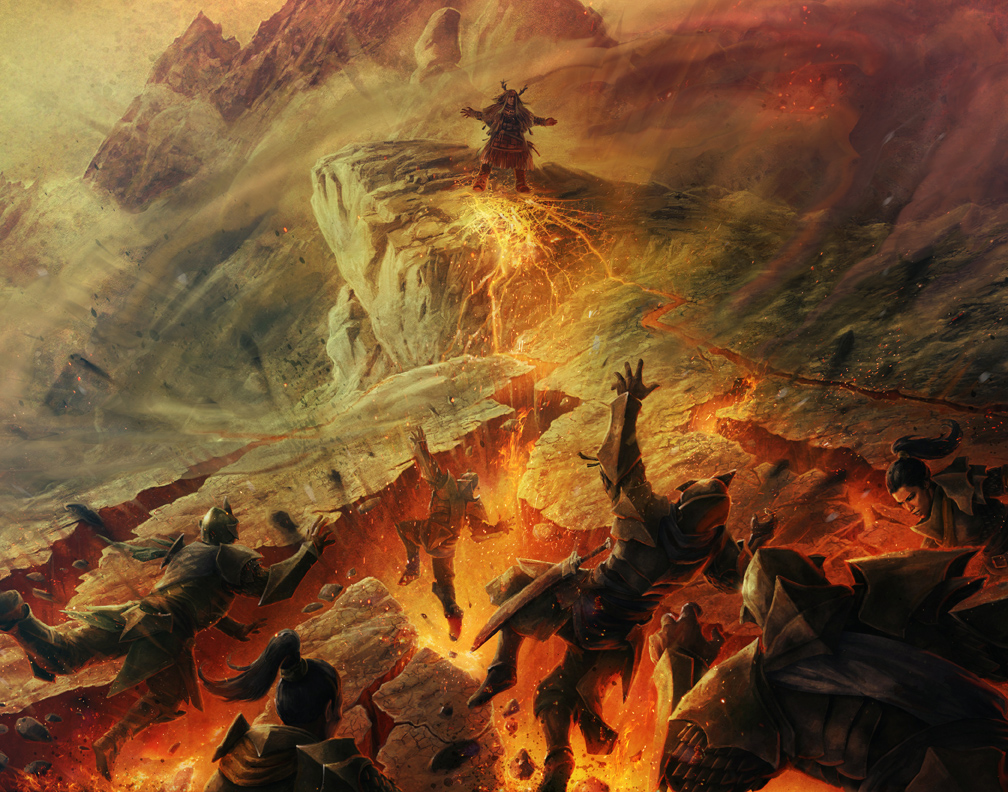Earthquake (spell)
Earthquake releases a burst of energy, causing a powerful tremor that shakes the ground surface in all directions. All persons within the area of effect are at the quake's mercy, unable to do anything except, at minimum, to fall to the ground. The caster is effectively the "epicentre" of the quake.
| Range | 120 ft. |
| Duration | see text |
| Area of Effect | 5 ft. radius per level |
| Casting Time | 4 rounds |
| Saving Throw | none |
| Level | cleric (7th) |
Perception and the victim's sense of direction are turned upside down. Only the caster is safe, standing in the "eye" of the spell's reverberations. Whatever happens, as things conveniently fall to the left or right, the caster isn't touched — even if the he or she happens to be inside a building that collapses. That said, the caster is as unable to take any sort of action once the earthquake is commenced, except as described below.
Resolution
Once the spell is discharged, the caster has little control over the earthquake's intensity. He or she must roll 3d6 (3-18) to determine how long the shaking lasts. The incident as it unfolds is described below, round by round. For example, if the caster rolled a "14," then the earthquake would run for 14 rounds, and then suddenly come to an end — all further effects and property damage ceases, with exceptions (see round 17).
- Rounds 1 to 3: creatures find themselves unbalanced, dropping their weapons and staggering to remain on their feet; buildings and trees start to sway back and forth. On the 3rd round, a violent shake drops everyone onto their hands and knees as hairline cracks appear on mortared patios and streets.
- Round 4: the shaking eases just enough that creatures can crawl a distance of no more than ten feet, giving themselves a chance to vacate a balcony, escape a building, jump or seek a doorway. Characters attempting to leave the earthquake area must make a dexterity check or fail to guess the right direction.
- Round 5: another hard shake in a random compass direction (1 to 8) tosses everyone and everything that's loose in the same direction; the shock causes 1-6 damage to everyone in the spell's area of effect.
- Round 6: another lull allows creatures to move another ten feet; and make another dexterity check to see if they can escape. Flying creatures are able to take to the air.
- Round 7: balconies and other unsupported masonry breaks and falls, shattering and causing 1-6 damage to anyone nearby. Shored tunnels have a 1 in 4 chance of collapsing this round and each round thereafter; natural bridges less than 2 ft. wide break and collapse.
- Round 8: shelters and structures made entirely of wood give way and fall, causing 2-12 damage to anyone inside.
- Round 9: the ground heaves and swells; wagons and carts roll over, ships take damage as they slam against quays, ships at sea roll and 1 in 6 sailors must make a dexterity check or be thrown overboard. Rents appear in the ground, breaking streets apart. Creatures are thrown this way and that, all suffering 1-6 damage. Caverns larger than 100 ft. across have a 1 in 12 chance of collapsing this round and each round thereafter.
- Round 10: half-timbered structures give way and collapse, causing 3-18 to anyone still inside. Overhanging ledges on mountains and hillsides give way and tumble.
- Round 11: another lull occurs, as in round 6.
- Round 12: natural bridges up to 5 ft. wide break apart and collapse. Roof tiles, branches and rigging falls from the sky and causes damage to anyone below. Ships take two points of rigging damage. Manicholations, battlements and tower roofs tumble from the tops of fortifications. Stone walls less than 6 in. in diameter give way and collapse.
- Round 13: every tree has a 1 in 8 chance of falling over, uprooted. Everyone suffers an additional 1-6 damage.
- Round 14: all structures taller than 30 ft. have a 1 in 6 chance of collapsing this round and each round thereafter.
- Round 15: structures taller than 20 ft. are also subject to a 1 in 6 chance of collapsing.
- Round 16: sections of the ground up to a hundred feet wide are pushed 3-18 feet into the air, tilting this way and that, causing everyone to suffer 2-8 damage from tumbling or being hit by rolling objects.
- Round 17: fissures open and groundwater fountains into the air, creating rivers of deluge and muck, which only begins to settle when the earthquake ends; water continues to pour forth for an additional 3-6 rounds after the earthquake stops.
- Round 18: one last powerful shock doubles the chance of everything collapsing.
